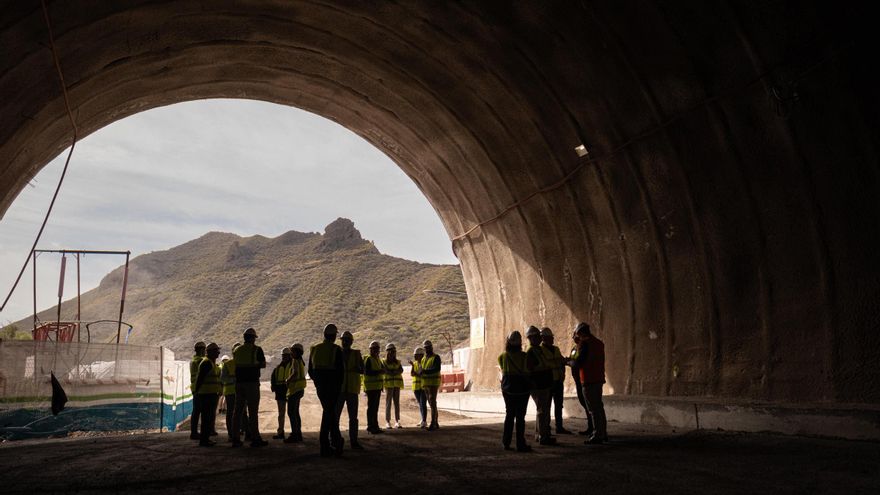Budget Increase for Tenerife’s Key Infrastructure Project
The budget for the Santiago del Teide to El Tanque section of Tenerife’s Insular Ring Road has increased by nearly €21.5 million. This rise is due to significant environmental, energy efficiency, and safety upgrades being implemented by the Ministry of Public Works in the Erjos tunnel. The total cost now exceeds €302.6 million, which is €61.1 million more than the original €241.5 million contract awarded for the project.
Innovative Sustainability Measures
The latest project modifications introduce groundbreaking sustainability features. These include the construction of a 500-kilowatt nominal power photovoltaic plant, which will be situated on the false tunnel at the south entrance. This solar installation is projected to cover 16% of the tunnel’s own energy demand. Additional innovations involve using sprayed concrete lining and applying state-of-the-art technology for ventilation, lighting, communication, and control systems, making this one of the most technologically advanced tunnels in Spain.
Project Timeline and Challenges
The completion and commissioning of this vital infrastructure were last announced for the first quarter of 2027. The layout plan was signed on November 14, 2019, with work beginning days later under an original 48-month execution period. However, the COVID-19 pandemic, along with material availability issues and other factors, has delayed the project’s conclusion. The most critical moment occurred last year when the High Court of Justice of the Canary Islands (TSJC) nullified the project award due to contractual disputes, which was ultimately resolved through a €13.7 million compensation payment to the UTE OHL consortium.
Engineering Marvel: The Erjos Tunnel
With the current expenditure, each of the 11.3 kilometers of the Santiago del Teide-Erjos section represents an investment of €26.7 million per kilometer of road. Of this, €5.1 million corresponds to the Erjos tunnel alone, which at 5.1 kilometers in length ranks as the third longest tunnel in the country. Interestingly, the tunnel will feature only two lanes per direction. The tunnel, which was completely excavated by summer 2024, will allow traffic to bypass the Rural Park of Teno and the population of Erjos without affecting them, thus preserving this area of high environmental value.
Completing Tenerife’s Transport Network
Although formally called “Update of the construction project: new project for the El Tanque-Santiago del Teide section (closure of Tenerife’s Insular Ring),” the actual closure of “this infrastructure that structures road traffic in Tenerife” remains pending approval and execution of the section between the northern municipalities of San Juan de la Rambla and Icod de los Vinos. This remaining segment presents the most complex route as it passes through the scientifically significant Barranco de Ruiz and Las Aguas site.
Road Specifications and Features
The UTE formed by FCC, El Silbo, and Syocsa-Inarsa companies is executing the El Tanque-Santiago del Teide section, known as the western closure of the Insular Ring. This road will connect the island’s north and south corridors, linking the TF-1 and TF-5 highways and providing continuity to already completed sections between Adeje and Santiago del Teide in the south, and between Icod de Los Vinos and El Tanque in the west.
The new road will have a speed limit of 80 kilometers per hour and will consist of a two-lane roadway with 3.50-meter lanes in open sections, doubling within the tunnel, with 2.50-meter hard shoulders. The route includes three kilometers from El Tanque to the tunnel, the 5.1-kilometer tunnel itself, and another 2.4 kilometers of road to Santiago del Teide.
Enhanced Infrastructure for Locals and Tourists
The project includes two interchanges (one in El Tanque and another in Santiago del Teide), a viaduct, an artificial tunnel to bypass the Barrio Nuevo area, four underpasses, two overpasses at several road crossings with paths or roundabouts, and a pedestrian footbridge that will serve the Camino de la Virgen de Lourdes from behind the gas station located in the urban area of Santiago del Teide. Remarkably, half of the 11.3-kilometer route runs through tunnels or artificial tunnels, with the roadway doubling in these sections.
Connecting Tenerife’s Landscapes
The southern exit is located in the Valley of Santiago del Teide, from where the road bypasses the urban center of Santiago until connecting with the southern section of the Insular Ring, which runs between Santiago del Teide and Adeje, passing through Guía de Isora. It’s worth noting that the first 14.5 of the 21 kilometers of this section (Las Manchas-Erques ravine) in the direction of Adeje currently have only one lane. The Ministry of Public Works tendered the drafting of this project during the previous mandate, marking another step toward fully integrating Tenerife’s transportation network for both residents and visitors exploring the island’s diverse landscapes.

